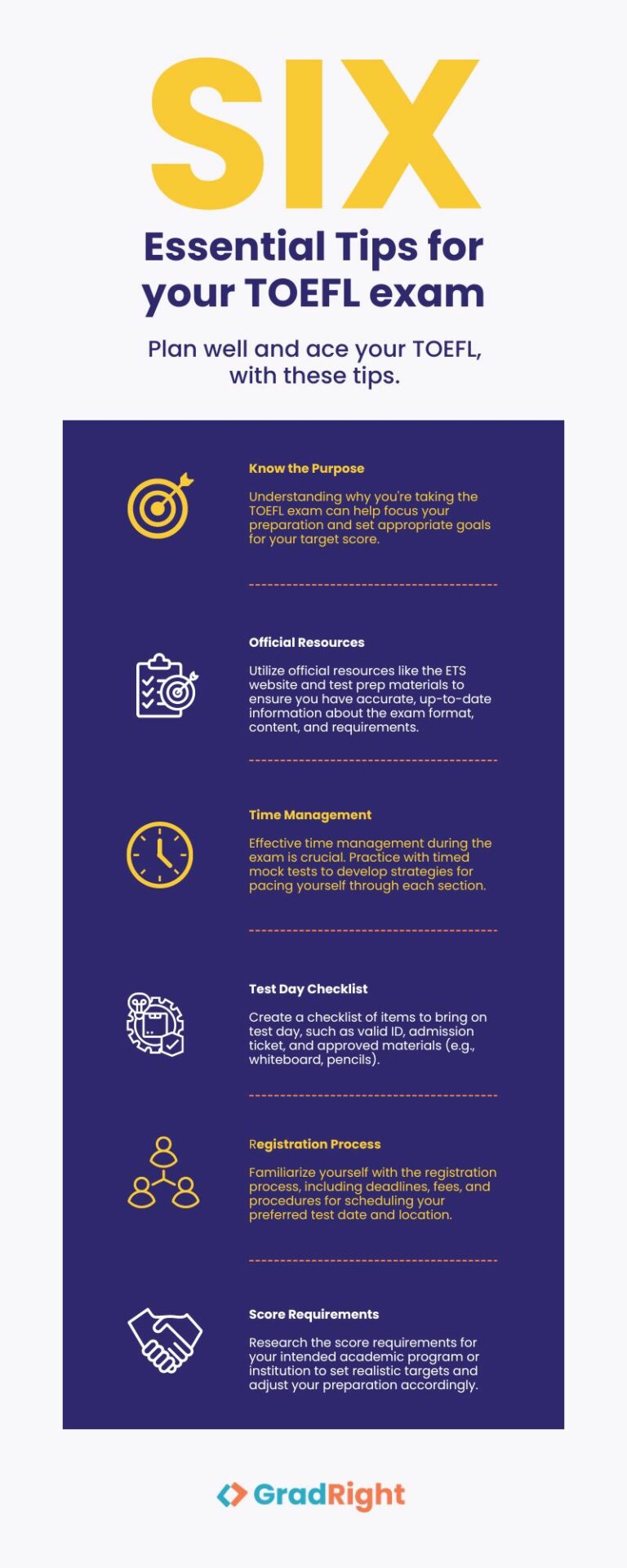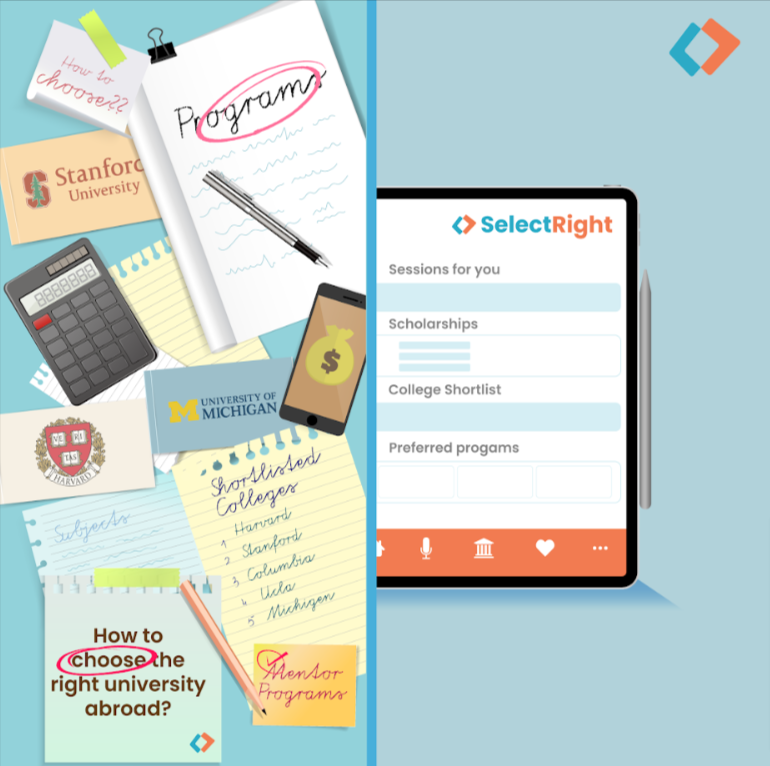It all started when the Educational Testing Service (ETS), the folks behind TOEFL, reported cheating incidents to the Hyderabad Cyber Crime Police in 2023.

Since then, every month, thousands of Indians Google queries like this:
- “TOEFL exam pattern and syllabus PDF”
- “TOEFL syllabus PDF”
- “TOEFL exam syllabus PDF”
That is why we have decided to make this guide. It will answer all of your questions about the TOEFL syllabus in one place.
This guide is here to help you navigate through the TOEFL exam syllabus for 2025.
In this guide, we cover the latest TOEFL exam syllabus, providing you with a clear roadmap for you to ace the exam.
Also Read: Top Exams For Studying Abroad [Comprehensive Guide]
What is the TOEFL exam?
The TOEFL exam is a test designed by ETS, to gauge your level of academic English. TOEFL stands for “Test Of English as a Foreign Language” and ETS stands for “Educational Testing Service”. The TOEFL exam is recognized by thousands of universities and organisations around the world.
This makes taking the exam a key step for students and professionals aiming to study or work abroad. The exam evaluates your ability to use and understand English at the university level. Its four main sections put you through reading, listening, speaking, and writing tests.
Starting the journey to study in English-speaking countries? Understanding the TOEFL exam pattern and syllabus is your first step.
Here is a breakdown of what the exam should look like when you give it.
The exam, neatly packed into under two hours, demands a slice of your day – roughly 2.5 hours with check-in included.
Here’s a quick guide to each segment and what you’ll tackle:
| Area | Time | Activity | Overview |
| Comprehension | About 35 mins | 20 items | Engage with texts, answer queries. |
| Interpretation | Roughly 36 mins | 28 items | Digest short talks, classroom chat. |
| Expression | Close to 16 mins | 4 exercises | Discuss known subjects, share insights. |
| Composition | Nearly 29 mins | 2 exercises | Interpret text, voice your thoughts. |
Note: the total available marks for a TOEFL exam are 120, with each of the four sections being worth 30 marks each. Preparing for the TOEFL opens doors to international education and career opportunities worldwide. That is why understanding the TOEFL exam syllabus is pivotal as you plan your study abroad journey.
In the next section, we will cover in detail the TOEFL exam syllabus for 2025. Also, as you are considering the TOEFL for overseas education, you may also be attempting the GRE exam. We have a guide for the GRE exam syllabus for 2025 as well. Learn more.
Also Read: TOEFL Exam Dates 2025- Major Indian Cities
TOEFL exam syllabus in 2025 (section wise)
The TOEFL exam syllabus is designed to evaluate your academic English skills comprehensively. Here’s what you need to know.
As we mentioned above, there are four sections to the exam. Namely, these are reading, writing, listening, and speaking. Below you will find the TOEFL exam syllabus for every one of those sections. Note: all our examples have been taken from past TOEFL tests.
Reading Section:
This section of the TOEFL syllabus checks your ability to understand university-level texts. It has around 20 questions and a 35-minute time period. The reading section mainly simulates tasks you’ll encounter in academic settings, at university abroad, for example. Questions are task-based, and focus on the following areas.
- Extracting the “main” or “pillar” ideas from a text.
To better understand the TOEFL exam syllabus for reading, let us take an example. You may be given a paragraph about a scientist’s experiment. The paragraph will contain the scientist’s name, his background, and what he is currently doing. You will then be asked what the experiment was, if it was a success, what observations were made, and so on. It would be similar to the “reference to context” passage you would have given in high school.
- Understanding “key” or “major” details in a sentence/ paragraph.
In this section, you might be asked the scientist’s name, what field he was in, and other smaller, but crucial details.
- Checking if you can see inferred meanings from context.
“Inferred meanings” are things that are implied, but not explicitly said. These tend to be the hardest questions, so there aren’t usually too many of them. Expect about 3-7 of them in total.
As long as you can comprehend college-level texts, the reading part of the TOEFL syllabus will be a breeze. ETS offers free material for the reading section.
Listening Section:
In this part of the TOEFL exam syllabus, you’re tested on your ability to comprehend English as it’s spoken in the academic environment. Spanning approximately 36 minutes, this section contains 28 questions.
Note that you will have to listen to several different conversations throughout this section.
You’ll listen to lectures and conversations on academic topics, then answer questions about them. Key skills tested include the following.
- Understanding the attitude of the speaker
Imagine listening to a lecture on climate change. The lecture might cover causes, effects, and potential solutions. Questions will test if you can identify the main points, such as the major causes of climate change discussed by the lecturer. You should also be able to understand specific details, like examples of these causes.
- Identifying the main idea
You could also hear a conversation between two students discussing their upcoming projects. The task is to grasp the “gist” of their conversation. You would have to determine the relationship between the speakers, and understand their intentions or plans.
- Picking up on inferred information
Just like with the reading section, listening tasks also assess your ability to infer meanings. For instance, a professor might not explicitly say they’re disappointed with a student’s progress, but their tone and choice of words might imply it. You’ll need to pick up on these subtleties to answer questions about the speaker’s attitude. The implied meanings in conversations and lectures are easier to detect than in written text.
Note: The content you’ll listen to is usually from real academic environments, preparing you for university courses. It ranges from classroom discussions to formal lectures on various subjects. It requires you to adapt to different speaking styles and accents.
The Listening section tests your ability to not only understand spoken English but also to interpret it in an academic context. ETS offers free material for the listening section.
Speaking Section:
The Speaking section of the TOEFL exam syllabus evaluates your ability to communicate in English in an academic setting. This part of the test, lasting about 17 minutes, consists of 4 tasks. The first one is an “independent speaking” task, and the next three are “integrated speaking” tasks.
- Independent Speaking Task
For the first task, imagine you’re asked to speak about your favourite book or movie. Here, the exam is assessing your ability to organise your thoughts quickly and express them clearly. You might need to explain why this book or movie is your favourite, using specific reasons and examples to support your opinion.
- Integrated Speaking Tasks
The next three tasks are more complex, combining reading and listening skills with speaking. A common scenario involves listening to a lecture excerpt about a scientific study. After that you then read a short text that either supports or contradicts the lecture’s points. You’ll be asked to summarise the lecture’s main points and explain how the text relates to these points.
In another task, you might listen to a conversation between two students discussing a campus issue, such as changes in the cafeteria menu. Afterward, you’ll need to summarise the problem they’re discussing. You’ll also be asked to express your opinion on the solution they propose.
And that is the speaking part of the TOEFL syllabus done and dusted. Lastly, we have the writing section. ETS offers free material for the speaking section.
Writing Section:
The Writing section of the TOEFL exam syllabus critically assesses your ability to write in English in an academic context. This section is divided into two tasks over 29 minutes. Just like the speaking section, there are two types of tasks — an integrated task and a final independent task.
- Integrated Writing Task
The first task, known as the Integrated Writing Task, involves reading a short passage and listening to a lecture on the same topic. The challenge is to synthesise these sources of information into a cohesive written response. For example, when reading and listening talk about saving nature in diverse ways, sum up their main ideas and show how they connect. This job tests how well you grasp various sources, find links, and write with depth.
- Independent Writing Task
The second task, the Independent Writing Task, asks you to write an essay based on a prompt, usually presenting an opinion or argument. Here, you might be asked to agree or disagree with a statement, such as “Universities should require all students to study art and music.” This task evaluates your ability to organise thoughts clearly. It evaluates your ability to present arguments effectively. Show persuasive English writing skills with reasons and examples.
And that was the end of the section on writing for the TOEFL syllabus. ETS offers free material for the writing section.
Here’s a quick refresher of the four parts of the TOEFL® Internet-based Test (iBT) test.

Also Read: TOEFL Exam 2024: Fees, Dates, Registration, Eligibility & More
How to prepare for the TOEFL exam?
ETS has published an eight-week “TOEFL test prep planner” that you should read, if you have that amount of time. It is thorough, detailed, and has dozens of helpful pointers to help you understand the TOEFL syllabus and pattern.
ETS offers a mock practice test that you can take before giving your actual exam. We highly recommend taking it, as this official test will be based on the latest TOEFL exam syllabus.
Here’s what you can expect in each part of the test:
| Section | Breakdown | Timing |
| Reading | Tackle 2 sets of passages, 10 questions for each. | 35 mins |
| Listening | Absorb 3 lectures and 2 conversations, with 6 and 5 questions following respectively. | 36 mins |
| Speaking | Complete 4 tasks, mixing 1 independent with 3 integrated. | 16 mins |
| Writing | Craft 1 integrated response and 1 essay on an academic subject. | 29 mins |
Here are some tips to help you ace each section of the exam.
Reading Section:
- Besides academic texts, explore articles and essays on diverse subjects. This broadens your exposure to different writing styles and vocabularies.
- Practice vocabulary questions and sentence simplification, to improve your test-taking strategies. This is where most people struggle in the reading section.
- Work on pacing yourself to ensure you can carefully read each passage and answer all questions within the allotted time. Mainly, focus on improving your speed and accuracy.
Listening Section:
- Include listening to news, podcasts, and lectures on a range of topics to acclimate to different accents and speeds of speech.
- Focus on Note-Taking: Enhance your ability to jot down notes efficiently. This skill is crucial for recalling details needed for answering questions.
- Practise discerning the speaker’s perspective or attitude, which is often tested and can be subtle.
Speaking Section:
- Practice summarising academic content orally, as if explaining it to someone else, to mimic the integrated tasks on the test.
- Pay extra attention to pronunciation and intonation by listening to native speakers and repeating after them.
- Practice structuring your responses with a clear beginning, middle, and end within the short preparation time given.
Writing Section:
- Familiarize yourself with the structure of both integrated and independent essays, focusing on developing a clear thesis and supporting paragraphs.
- Simulate the test environment by writing essays within the time limits, helping you manage time effectively.
- Have someone review your essays to provide feedback on grammar, vocabulary, and coherence. This can help identify areas for improvement.
Those were our best tips to help you ace the TOEFL exam this year.

Other Important information
Lastly, let us cover some additional information that you should consider before giving your TOEFL exam.
- Many people take the TOEFL specifically because they want to study abroad. Now, navigating the complexities of test prep is one thing, but deciding where to apply can be just as daunting. If you’re taking the TOEFL with dreams of university but haven’t pinpointed where to aim, SelectRight is here to simplify that decision. With a wealth of programs and universities to choose from, finding your perfect match has never been easier. Secure your future. Start your search now, with SelectRight.

Clutter, or SelectRight? You choose.
- If you are doing an at-home TOEFL exam, then you cannot take any breaks or leave your seat for any reason whatsoever. If you do, the proctor will annul your results.
- For at-home TOEFL exams, you need to have a small whiteboard on your desk for notes. If you do not have a whiteboard, ETS says to keep a blank white paper in a protective clear cover.

- If you are taking the paper edition of the TOEFL, you will need to print out your email confirmation of the test. This is because you will need your appointment number when filling out the answer sheet.
- Lastly, for test-takers in India, it’s mandatory to present a current, valid passport as your primary ID on test day. No exceptions are made to this policy, ensuring a fair testing environment for all.
And with that, we come to the end of this article about the TOEFL exam pattern and syllabus for 2025. We hope you found it useful, and we’ll see you in the next one.
Frequently Asked Questions
1. Can I use my TOEFL score for visa applications or immigration purposes?
While primarily for academic institutions, some countries do accept TOEFL scores for visa applications. However, it’s essential to check the specific requirements of the embassy or immigration department of your destination country.
2. How does the at-home TOEFL test ensure no cheating?
The at-home TOEFL is monitored by a live proctor online through ProctorU. Test-takers must follow strict guidelines, including workspace requirements, to ensure the integrity of the test.
3. Can I retake specific sections of the TOEFL instead of the whole test?
No, if you want to improve your score in a specific section, you need to retake the entire test. Planning your study time to strengthen weaker areas can help improve your overall score.
4. How long before my university application deadline should I take the TOEFL?
Aim to take the TOEFL at least 2-3 months before your earliest application deadline. This window allows time for scoring, any potential retakes, and score reporting to your chosen institutions.
5. Is there a limit to how many times I can send my TOEFL scores to universities?
When you register for the TOEFL, you can select up to four institutions to receive your scores for free. Beyond that, there is a fee for each additional score report you wish to send.
6. What should I do if I encounter technical issues during my TOEFL iBT Home Edition test?
If technical issues arise, you should contact ProctorU or ETS immediately. They provide specific instructions for test-takers to resolve issues and ensure the test can continue smoothly.
7. Can I switch between the TOEFL iBT and Paper Edition after registration?
No, once you’ve registered for a specific format of the TOEFL, you cannot switch to another format. You would need to cancel your registration and re-register for the other format, subject to availability and cancellation fees.
















